Liquid stones on nails: features of manicure and subtleties of execution
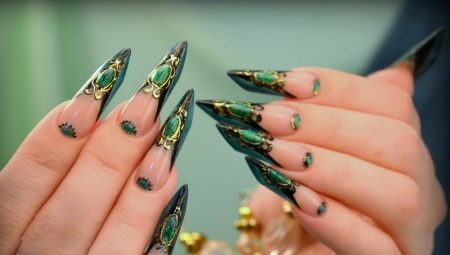
There is no better decoration for women's pens than a neatly executed manicure. Varnished nails are the perfect companion for original rings, watches and bracelets.
The nail service industry does not stand still, new types of designs are constantly appearing. This is exactly what the "liquid stone" technique refers to, which will be discussed today. This design is so special and interesting that it certainly deserves a separate story.

What it is?
For the first time this type of design was proposed by the Russian master of nail service Ekaterina Miroshnichenko.
In another way, liquid stones on the nails are called casting. These are not rhinestones that are attached over the applied varnish and often fall off during wear. This is a gemstone imitation design. This technique looks pretentious, bright, and, probably, not every woman is able to walk with such a manicure every day. However, as an option for going out or for ladies who do not want to make their everyday life gray, this design is a great find.
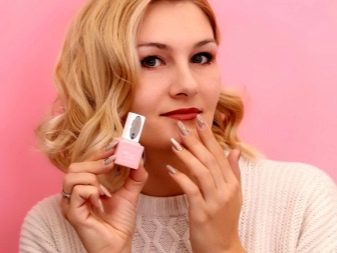
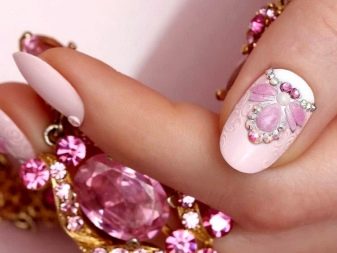
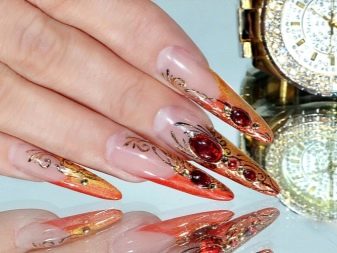
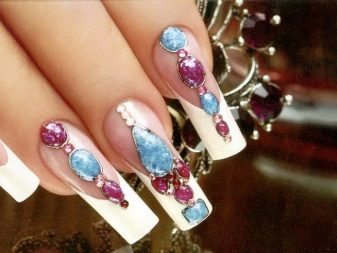
A combination of polymer and sculpting gel is used to create a natural gemstone effect on the nail. There are no protrusions and depressions, as when attaching rhinestones and sequins, on the nail, it is perfectly even. However, thanks to the effect of a magnifying glass, an optical illusion is created that the stone on the nail plate is real.

Advantages and disadvantages
Is this manicure technique beautiful? This question has no clear answer. Supporters of minimalism or naturalness will answer “no” and will be right in their own way - for them, such pretentiousness in decorating their own hands is equal to ugliness, unaestheticness.If a woman has been faithful to a classic jacket or a monochromatic scarlet varnish for many years, she will feel uncomfortable with casting on her nails, and, of course, she will not be decorated with such a manicure.
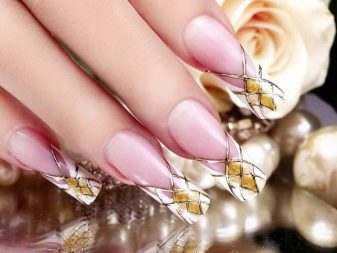
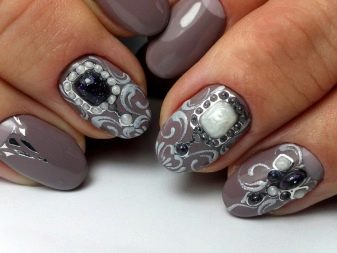
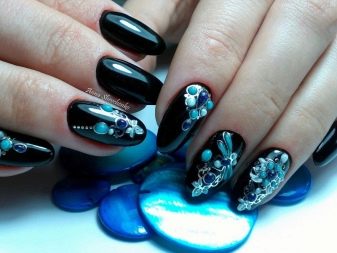
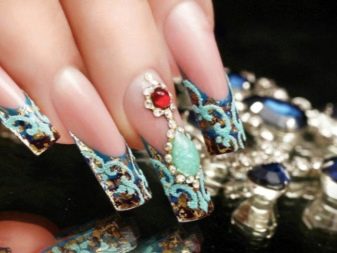
Ladies who love variety in decorating themselves, not afraid of experimenting with appearance (and sometimes boldly going to them) will say their resolute "yes" and again they will be right - after all, it is for them that such a design will not be excessive, nor vulgar, nor the notorious "dear-rich". On the contrary, it will be an organic complement to the image, a piquant detail that draws the eye to the hands and shows them in a favorable light.
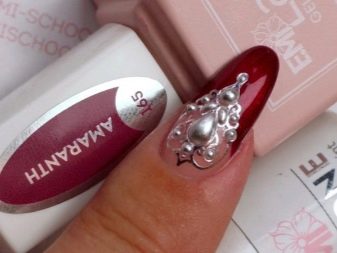
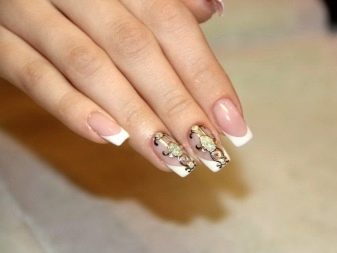


Without going into disputes about the beauty and aesthetics of such a design (after all, these criteria are different for everyone), let us dwell on its other advantages.
- Stability and strength. Latex and polymer stones will not snag on tights or scarves, and will not damage your appearance. They do not tend to fall off at the most inopportune moment, ruining the impression of the entire manicure.
- This design is easy to wear, despite its seeming "heavy weight".
- When worn neatly, it lasts from two weeks to one month.
- Manicure is practical, does not interfere with household chores and routine daily work.

However, there are drawbacks to this sophisticated design.
- Like any other "heavyweight", multi-layered manicure, liquid stones spoil the nails. Therefore, you should choose only the highest quality materials, so as not to spend several months in the future on the restoration of the nail plates.
- This technique requires a lot of professionalism from a nail service master. Done sloppily, poorly or roughly, such a manicure, firstly, will not look elegant, but, on the contrary, will emphasize all the flaws in your hands, and, secondly, it can cause great harm to your nails.
- Even if you have found a professional master, you should not "re-wear" your nails for more than one month, and do designs one by one. After each "heavy" manicure, you need to give your nails a break, do a medical manicure and pamper them with home or salon care from baths, oils and creams at least for a week. Of course, vitamin complexes for strengthening nails will also not be superfluous.
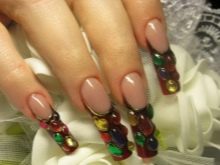
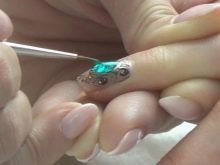
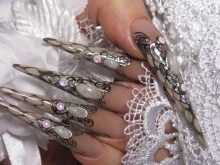
What nails are suitable for?
If you wear short nails, this can be an obstacle to casting and liquid stone designs. Indeed, for a beautiful application of manicure in this technique, you need "room for maneuver" (the "stone" itself cannot be less than 3 mm), which is why it was originally conceived and used only for extended nails. Now modern materials allow liquid stones to be worn on natural nails, but they must be long.
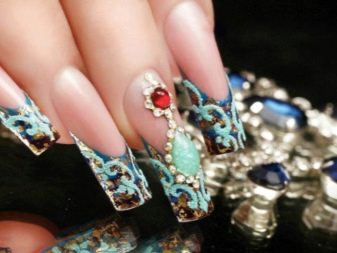
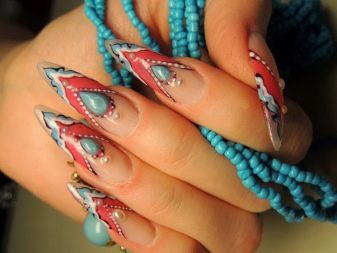
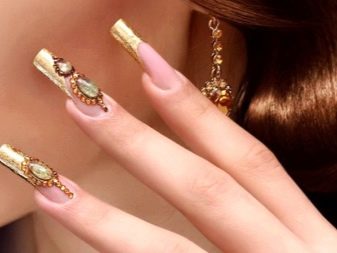
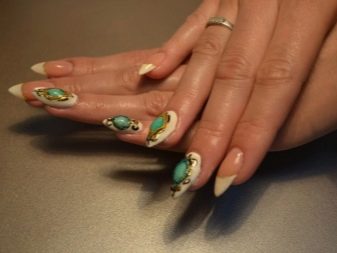
And yet, most often this type of design is performed on artificially extended acrylic nails. It is on them that liquid stones are best held due to the adhesion of acrylic and the polymer substance from which the stone is made. In addition, natural nails are prone to breaking in the stress zone, and this trouble does not happen with acrylic.
Design options
There are quite a few types of manicure using casting and liquid stones. First of all, they differ in the color and size of the stones used - whether it will be "ruby", "amber" or "emerald". Or maybe pearls will sparkle on the nails? The size of jewelry also varies - from 3 mm and up to the length allowed on the free edge of the nail. For competitive entries, where the design is made on long and very long nails, specially built up for the competition, stones can take on the most bizarre shapes and sizes, and also be folded in a combination of three, five or seven pieces.
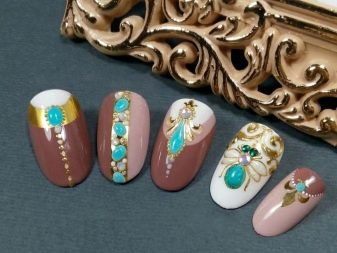
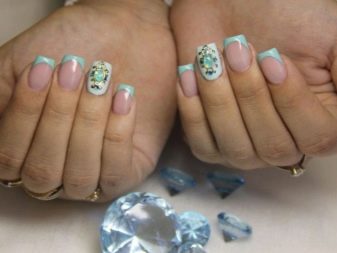
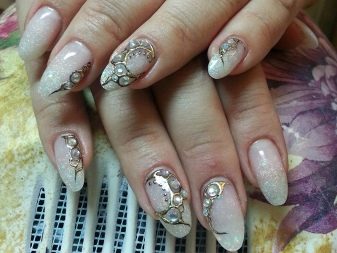
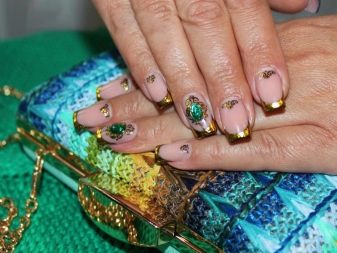
Stones can be not only separate elements in nail design, but also act as an independent manicure. For example, marble on nails, which is so popular nowadays, is nothing more than a liquid stone. In the same technique, you can make turquoise - both bright blue and artificially aged greenish.Malachite with its veins and overflows will look great. Jasper, pearls, even diamonds - all conditions have been created for imagination! If the master of nail service is a real ace in his field, he will be able to do everything - from amber with particles of sand to marble with gold veins.
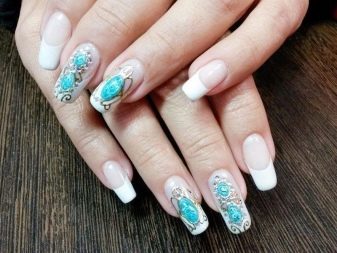


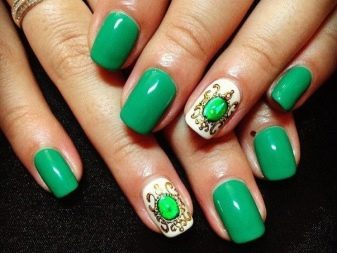
You can design on one nail, on two, or even on all - for example, marble or turquoise. The main thing is not to overdo it with an abundance of details and not turn an exquisite and sophisticated manicure into the hands of a Soviet saleswoman strewn with "stones" in the worst sense of this phrase. Even if you really like this type of design, you should also consider how appropriate it will be in your usual routine, whether it is acceptable with the dress code that exists in many organizations, whether you will feel comfortable with this manicure, whether it will excessive, and, of course, whether it suits your style and image. If you answered “yes” to all of the above questions, then you can wear liquid stones without regard to the opinions of others!
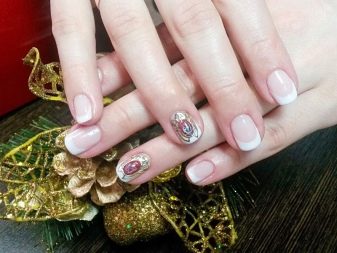
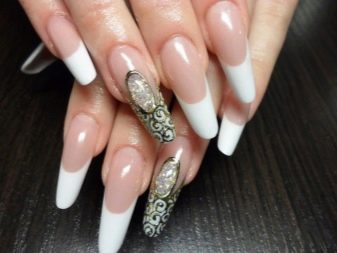
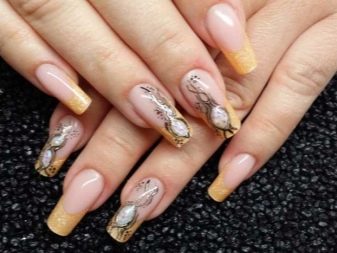
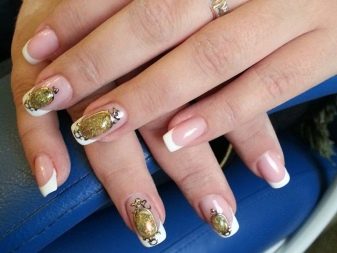
How to do it right?
Before describing step by step the application of a liquid stone to the nail, let us briefly dwell on the materials that will be required for this (and there are quite a few of them).
So, what kind of "helpers" are needed to work in the "casting" technique.
- Colored gel base for French manicure.
- Gel protection (cannot be dispersed).
- Black gel polish, as well as special paint for applying the contour of the stone. It is important to choose a contour paint so that foil can be printed on it without any problems.
- Gel with stained glass effect (needed to simulate stone texture). The shade is chosen depending on the simulated stone.
- A sculptural gel with a viscous texture.
- Brushes for nail art: angled to apply the base coat, "hair" for contouring and working - to apply the rest of the layers.
- Manicure foil in gold or silver.
- UV lamp or LED lamp for layer-by-layer gel polymerization.

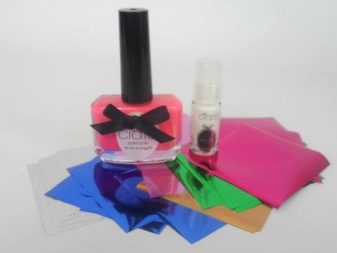
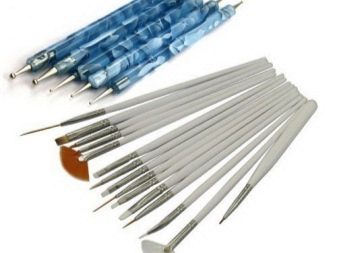
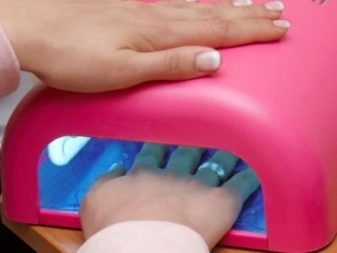
Now let's move on to the technology of applying liquid stones to nails. How is this done?
- On each nail plate, on which it is planned to do this type of design, a "smile" of French manicure is drawn. An angled brush is suitable for this. After application, the layer is dried in a lamp.
- Next, you should apply the gel protection and put your hands back in the lamp to dry.
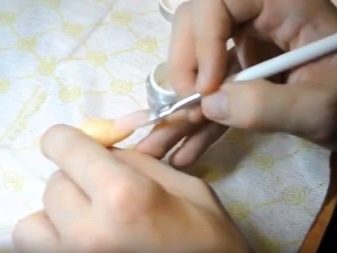
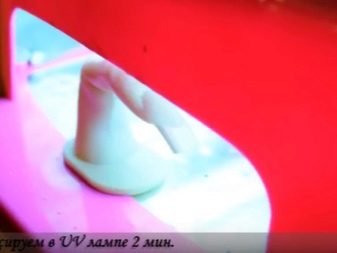
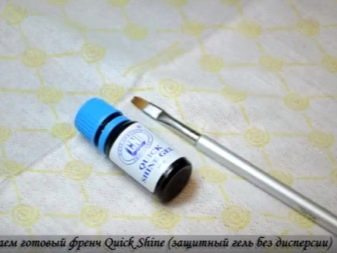
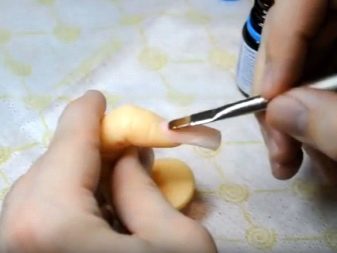
- After that, the preparatory stage begins for applying the design itself. The planned pattern is applied with a "hair" brush using a black gel. If you are inexperienced, you should not use an overly complex ornament. If you do not have enough imagination to create your own, author's pattern, you can take any necklace or brooch with rhinestones or stones and transfer the print to the nail plate. The place where the stone will be located is drawn especially carefully. Next, you should dry your nails again.
- At the end of drying, you need to carefully apply foil to the drawn pattern - silver or gold. This is done as follows: a piece of foil is taken in size that matches the nail plate, applied to the previously applied pattern, pressed with your fingers and removed in one motion. This process is called "casting". So the "stone" is placed in a frame, respectively, gold or silver.
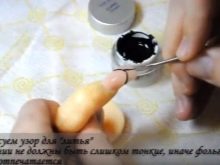
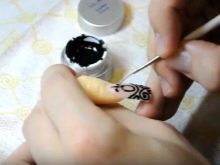
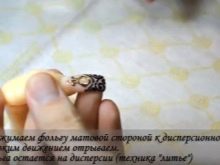
- Further, colored gels are applied along the contour of the "stone" blank. This is done with a thin brush. Sharp color transitions are unacceptable, the overflows should look very smooth and neat. After that, the nails must be dried again.
- Take your chosen stained glass effect gel and use a "hair" brush to apply it to the resulting "stone". So it will begin to overflow. Place your nails back into the lamp.
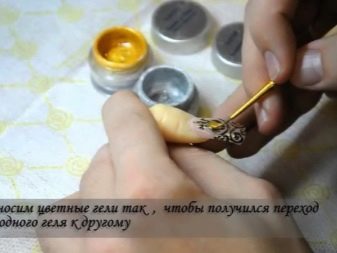
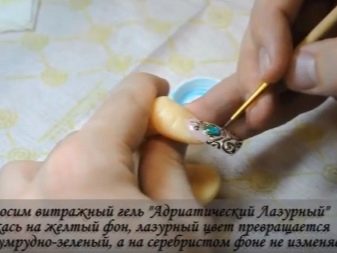
- After that, you should start forming the volume of the stone. A sculpturing thick gel applied in a spherical manner will help with this. With this method of application, the optical effect of a "magnifying glass" is obtained, and the stone looks real and voluminous. The nail is dried again in the lamp.
- All that remains is to apply the top with a basic brush. The nail with the top applied should not have bumps, depressions and dents, it should give a perfectly even glare. The top layer should be dried again in the lamp. Your design is ready.
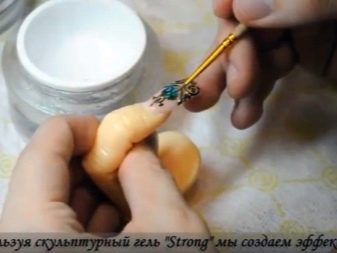
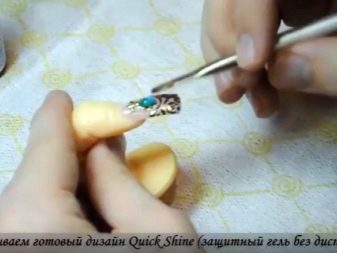
Let's make a reservation that this method of application is basic. It requires considerable skill in application, which can only be achieved through practice. Therefore, if you want to make such a design yourself, you need to prepare for a long journey of trial and error.
Interesting examples
This section shows several unusual works.
- The combination of varnish with the effect of "cat's eye" and "marble" looks interesting and unusual. Suitable for both going out and daily wear.
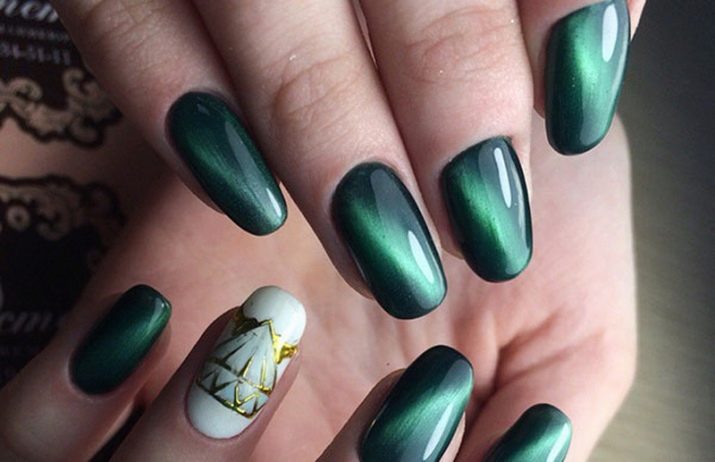
- A traditional jacket in combination with a large purple stone looks sophisticated and discreet. Suitable even for the most modest young ladies.
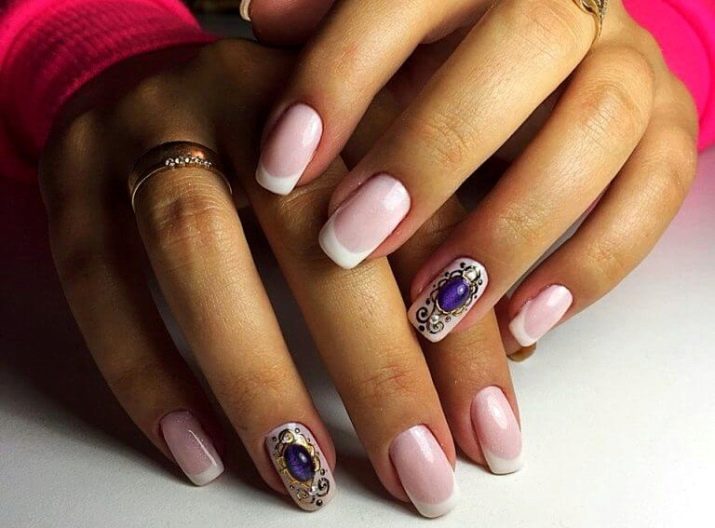
- "Opal" in a gold frame on very long nails looks really luxurious. Possible only on acrylic nails, however, the result will justify all the efforts.
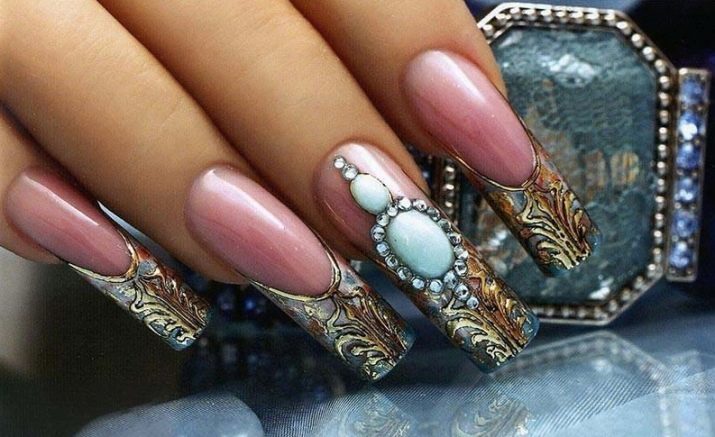
- Moon manicure in combination with stones is original and even extravagant. Suitable for lovers of sports chic.
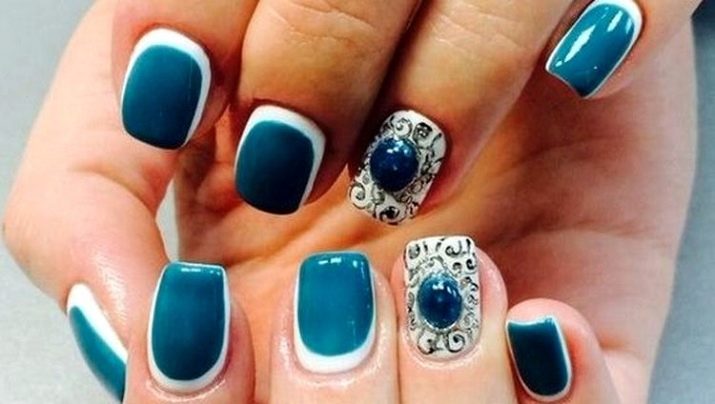
- The classic combination of scarlet, white and "ruby" is the choice of brave women who are not afraid to be noticed.
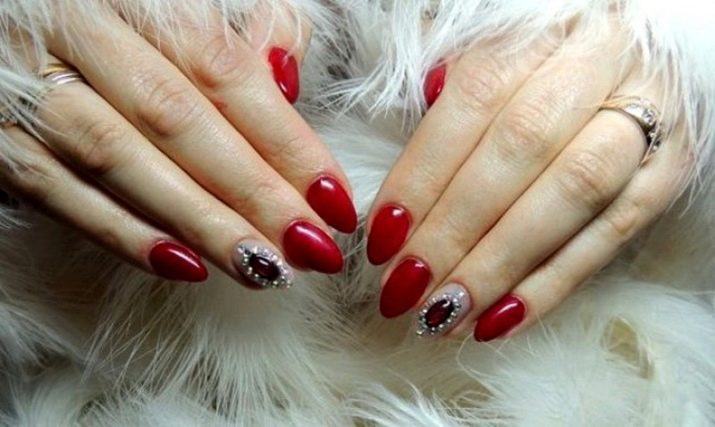
- "Malachite" looks great in a manicure. Combined with matching jewelry, it will make you the star of any event.
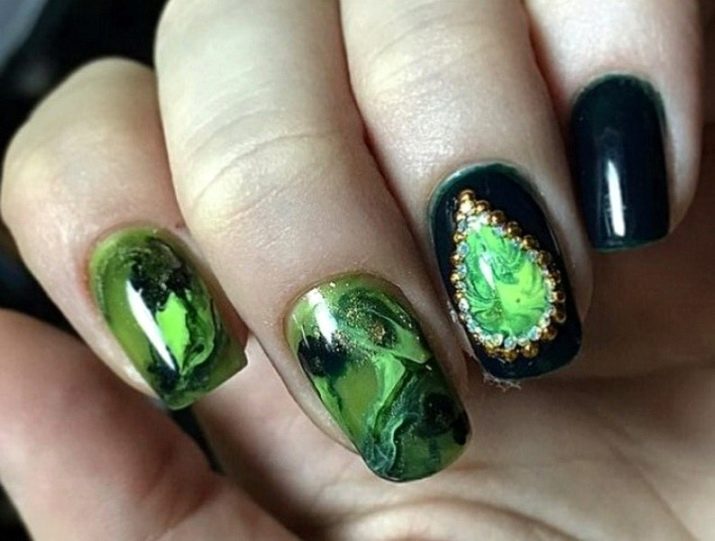
For information on how to design nails using the "liquid stones" technique, see the next video.








